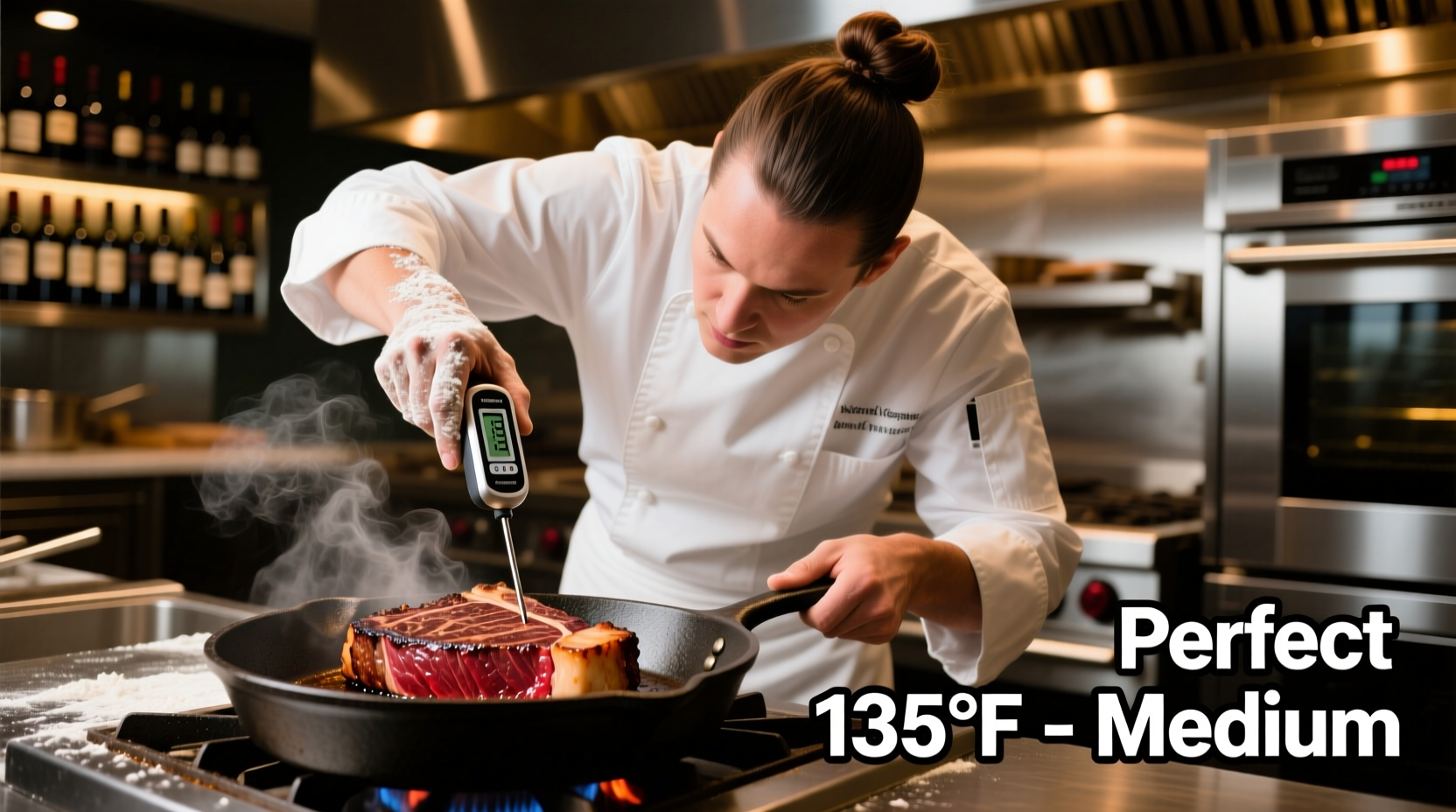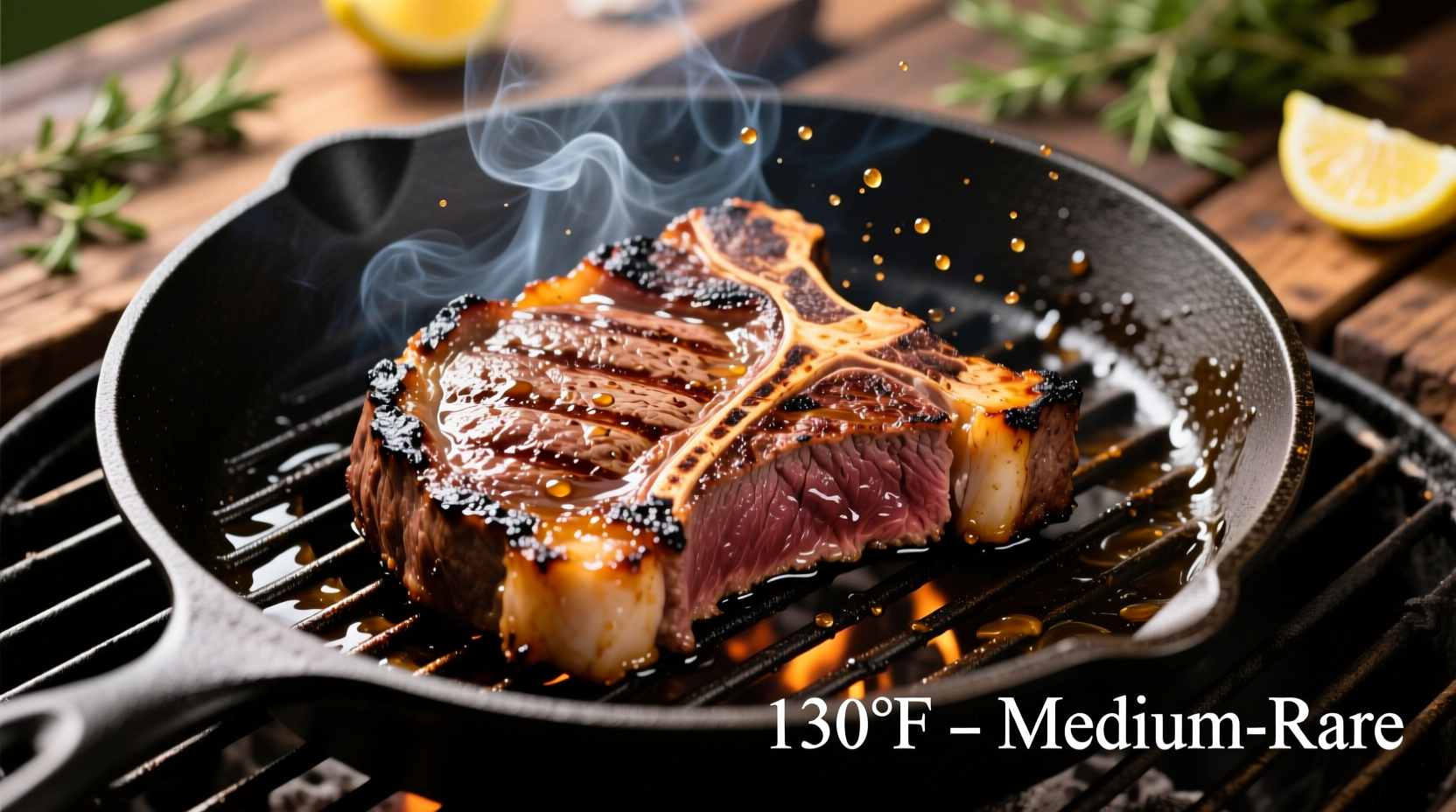The ideal grill temperature for cooking steak is 400-450°F (204-232°C) for most cuts. For perfect results, sear steaks at high heat (450°F+) for 2-4 minutes per side, then move to medium heat (350-400°F) to finish cooking to your desired doneness. Always use a meat thermometer to check internal temperatures: 120-125°F for rare, 130-135°F for medium-rare, 140-145°F for medium, and 150-155°F for medium-well.
Grilling the perfect steak isn't just about heat—it's about understanding the precise temperature relationship between your grill and the internal temperature of your meat. As a professional chef with experience in both high-end restaurants and backyard cooking, I've helped thousands of home cooks transform their grilling results. This guide delivers the exact temperature specifications you need, backed by food science and professional kitchen experience.
Why Temperature Matters More Than Timing
Many home cooks rely on cooking time to determine steak doneness, but this approach fails because steak thickness, starting temperature, and grill variations dramatically affect results. Temperature is the only reliable indicator of doneness. Using both grill surface temperature and internal meat temperature gives you complete control over your cooking process.
The Two-Temperature System: Grill Heat vs. Internal Steak Temperature
Successful steak grilling requires monitoring two distinct temperature measurements:
| Temperature Type | Ideal Range | How to Measure | Why It Matters |
|---|---|---|---|
| Grill Surface Temperature | 400-450°F (204-232°C) | Infrared thermometer or hand test (2-3 seconds) | Determines sear quality and cooking speed |
| Internal Steak Temperature | Rare: 120-125°F Medium-rare: 130-135°F Medium: 140-145°F Medium-well: 150-155°F |
Instant-read meat thermometer | Guarantees perfect doneness and food safety |
Step-by-Step Temperature Guide for Perfect Grilled Steak
1. Preparing Your Grill for Optimal Temperature
Whether using gas or charcoal, proper preheating is essential. For gas grills, preheat on high for 10-15 minutes with the lid closed. For charcoal, wait until coals are covered with gray ash (about 20 minutes). The USDA Food Safety and Inspection Service confirms that proper preheating kills surface bacteria and creates better sear marks (source).
2. Creating Temperature Zones for Control
Professional chefs use a two-zone fire method for precise temperature control:
- Direct heat zone: 450°F+ for searing (flames directly under cooking area)
- Indirect heat zone: 300-350°F for finishing (no flames directly under cooking area)
This setup allows you to move steaks between zones as needed, preventing burning while achieving perfect internal temperatures.
3. Searing: The Critical First Step
Place your seasoned steak directly over the high-heat zone. You should hear an immediate sizzle. For 1-1.5 inch thick steaks:
- Rare: 2-3 minutes per side
- Medium-rare: 3-4 minutes per side
- Medium and beyond: 4-5 minutes per side before moving to indirect heat

4. Finishing to Perfect Doneness
After searing, move steaks to the indirect heat zone. Continue cooking until they reach your target internal temperature. Remember that temperature will rise 5-10°F during resting (carryover cooking). Remove steaks from the grill when they're 5°F below your target temperature.
| Steak Cut | Recommended Grill Temp | Thickness | Target Internal Temp | Approx. Total Cooking Time |
|---|---|---|---|---|
| Ribeye (marbled) | 425-450°F | 1.5 inches | 130-135°F (medium-rare) | 10-12 minutes |
| Filet Mignon | 400-425°F | 1.5-2 inches | 125-130°F (medium-rare) | 12-15 minutes |
| New York Strip | 425-450°F | 1.25 inches | 130-135°F (medium-rare) | 8-10 minutes |
| Flank Steak | 450°F+ | 0.75 inches | 120-125°F (rare) | 4-6 minutes |
Context Boundaries: When Standard Temperatures Need Adjustment
While the temperature guidelines above work for most situations, certain conditions require adjustments:
- Thin cuts (under 1 inch): Use higher heat (450-500°F) but reduce cooking time significantly to prevent overcooking
- Cold weather grilling: Increase preheating time by 5-10 minutes and expect slightly longer cooking times
- Very thick cuts (2+ inches): Start with lower heat (350-400°F) to cook through without burning the exterior
- Lean cuts (like filet): Cook to lower internal temperatures as they dry out more easily than marbled cuts
Troubleshooting Common Temperature Problems
Problem: Steak is burning on the outside but raw inside
Solution: Your grill is too hot. Reduce to medium heat (350-400°F) after initial sear. For thick steaks, try reverse searing—cook first at low heat (275°F), then finish with a quick sear.
Problem: Steak is taking too long to reach desired temperature
Solution: Your grill isn't hot enough. Preheat longer or clean grates to improve heat transfer. Ensure you're using an accurate thermometer—many inexpensive models are unreliable.
Problem: Inconsistent results between steaks
Solution: Let steaks come to room temperature (30-60 minutes) before grilling. Cold steaks from the refrigerator will cook unevenly. The Academy of Nutrition and Dietetics recommends this step for more consistent cooking results (source).
Essential Tools for Temperature Control
Invest in these temperature tools for consistent results:
- Instant-read thermometer: Thermapen ONE or similar (critical for accuracy)
- Leave-in probe thermometer: For monitoring without opening the grill lid
- Infrared thermometer: To check grill surface temperature
- Timer: But don't rely solely on time—always verify with a thermometer
Resting: The Final Temperature Step
Never skip resting! After removing from the grill, let steaks rest for 5-10 minutes (longer for thicker cuts). During this time:
- Internal temperature rises 5-10°F (carryover cooking)
- Juices redistribute throughout the meat
- Fibers relax, resulting in more tender steak
Cover loosely with foil to retain heat but prevent steaming. Cutting too soon releases precious juices onto your cutting board.
Food Safety Considerations
While many prefer medium-rare steak (130-135°F), the USDA recommends cooking steaks to a minimum internal temperature of 145°F for safety, followed by a 3-minute rest (source). For vulnerable populations (elderly, young children, immunocompromised), consider cooking to at least medium (140-145°F).











 浙公网安备
33010002000092号
浙公网安备
33010002000092号 浙B2-20120091-4
浙B2-20120091-4